Amy Corwin's Blog, page 7
September 6, 2012
Guest Author: AJ Neust and Mystical Press
We're taking a break from my recent blogs on roses (a topic I just can't seem to shut up about) and meeting with author AJ Neust today. If you've ever thought about writing, there is a lot of good stuff here, so enjoy!
Mystical Press
Greetings and Salutations!
Many thanks to Amy for hosting us on her blog today! We’ve got some really exciting news to share with everyone so grab that cuppa and let the blogging begin!

September 1-15th marks the officialGrand Opening of Mystical Press Services!!!This means 50% Off all our classesand services through September 15th!http://mysticalpress.com
 In case you haven’t yet heard about our website, allow me to introduce you to a place where you just might find the fulfillment of your dreams. That’s right! The talented folks at Mystical Press want to help you reach your publishing goals!
In case you haven’t yet heard about our website, allow me to introduce you to a place where you just might find the fulfillment of your dreams. That’s right! The talented folks at Mystical Press want to help you reach your publishing goals!
 How do we do that? I’m glad you asked!
How do we do that? I’m glad you asked!
 Mystical Press is the culmination of an idea that came from two authors and professionally trained editors—Arial Burnz and AJ Nuest—where we help authors bridge the gap between the form rejection letter and publication. In fact, we believe in this venture so passionately, our tagline is “Helping authors achieve their dreams.”
Mystical Press is the culmination of an idea that came from two authors and professionally trained editors—Arial Burnz and AJ Nuest—where we help authors bridge the gap between the form rejection letter and publication. In fact, we believe in this venture so passionately, our tagline is “Helping authors achieve their dreams.”
At Mystical Press our primary goal is to help writers. As authors, we understand the frustration of not receiving constructive and useful feedback, the aggravation of navigating the murky depths of the publishing industry and that, sometimes, authors just need a place to vent. Well, we’re here to tell you, the insanity can end!
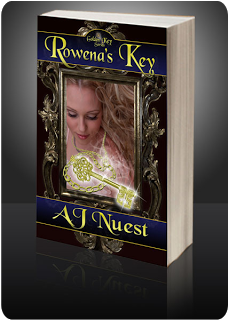 Like-minded individuals can gather online at Mystical Press to work one-on-one with professional editors who help authors prepare their manuscripts for submission. Whether you are looking for a Manuscript Evaluation, Submission Evaluation, or a full story edit, we will give you honest, encouraging feedback and work diligently with you on your story to make sure it’s ready to land on an editor’s desk. No project is too big or too small and all receive the same precise attention to detail.
Like-minded individuals can gather online at Mystical Press to work one-on-one with professional editors who help authors prepare their manuscripts for submission. Whether you are looking for a Manuscript Evaluation, Submission Evaluation, or a full story edit, we will give you honest, encouraging feedback and work diligently with you on your story to make sure it’s ready to land on an editor’s desk. No project is too big or too small and all receive the same precise attention to detail.
Perhaps your submission is ready but you need assistance with smaller editing projects like a query letter and synopsis? Have no fear! Mystical Press is here! We offer a full edit of query letters and synopses with comments and suggestions that come directly from AN EDITOR! TAH-DAH!
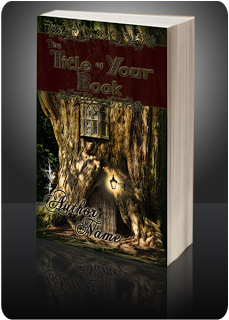 And don’t worry! If your goal is to write your very own dynamite synopsis, at Mystical Press we believe in “teaching a man to fish”. Our Power Class, How to Write a WINNING Synopsis, is designed to easily guide you through the process of crafting your very own synopsis! Yes, that’s right. I used “easily” and “synopsis” in the same sentence!
And don’t worry! If your goal is to write your very own dynamite synopsis, at Mystical Press we believe in “teaching a man to fish”. Our Power Class, How to Write a WINNING Synopsis, is designed to easily guide you through the process of crafting your very own synopsis! Yes, that’s right. I used “easily” and “synopsis” in the same sentence!
The self-paced course curriculum at Mystical Press can assist in tackling those pesky problem areas as well (e.g., show vs. tell, POV shifts, realistic character and story development, etc.). If you’ve read books, articles and/or taken workshops and are still in search of that elusive contract offer, perhaps Mystical Press can help. Take one class or take a whole series—our online classes are designed to meet each writer’s individual needs.
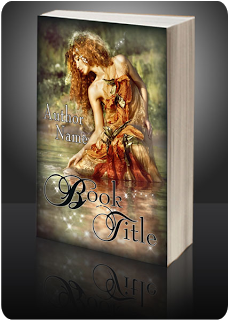 Is your next project of the self-publishing variety? Mystical Press has a selection of pre-made covers we guarantee will only be used once! No one will have the same cover! Or, if you’d like, we can design a cover specifically tailored to your vision—you will work one-on-one with our talented cover artists! We are also happy to edit your baby and can even format the document to meet the specifications of most popular self-publishing platforms.
Is your next project of the self-publishing variety? Mystical Press has a selection of pre-made covers we guarantee will only be used once! No one will have the same cover! Or, if you’d like, we can design a cover specifically tailored to your vision—you will work one-on-one with our talented cover artists! We are also happy to edit your baby and can even format the document to meet the specifications of most popular self-publishing platforms.
Remember to mention Mystical Press to all your friends and fellow writing pals – here’s why. Mystical Press offers a free Referral Program. Just register on the site and we will assign you a Referral ID. If anyone clicks on your link and makes a purchase, you earn a referral fee! Whether you choose cash or a credit for products or services on the site, consider this our thank you for helping us spread the word.
Oh! And before I forget…we offer a wide range of gift certificates designed specifically with the writer in mind. Tired of searching for the “write” present for your author pals? Maybe that next birthday calls for an eGift from Mystical Press!
So now that you know all about us, please tell us all about you! Head on over to Mystical Press and register free on the site. Everyone who does will be entered into our drawing for fabulous gifts and prizes! Join our celebration and together we will strive to get your voice heard!
Fiction Writing and Other Oddities
Mystical Press
Greetings and Salutations!
Many thanks to Amy for hosting us on her blog today! We’ve got some really exciting news to share with everyone so grab that cuppa and let the blogging begin!

September 1-15th marks the officialGrand Opening of Mystical Press Services!!!This means 50% Off all our classesand services through September 15th!http://mysticalpress.com
 In case you haven’t yet heard about our website, allow me to introduce you to a place where you just might find the fulfillment of your dreams. That’s right! The talented folks at Mystical Press want to help you reach your publishing goals!
In case you haven’t yet heard about our website, allow me to introduce you to a place where you just might find the fulfillment of your dreams. That’s right! The talented folks at Mystical Press want to help you reach your publishing goals!
 How do we do that? I’m glad you asked!
How do we do that? I’m glad you asked!
 Mystical Press is the culmination of an idea that came from two authors and professionally trained editors—Arial Burnz and AJ Nuest—where we help authors bridge the gap between the form rejection letter and publication. In fact, we believe in this venture so passionately, our tagline is “Helping authors achieve their dreams.”
Mystical Press is the culmination of an idea that came from two authors and professionally trained editors—Arial Burnz and AJ Nuest—where we help authors bridge the gap between the form rejection letter and publication. In fact, we believe in this venture so passionately, our tagline is “Helping authors achieve their dreams.” At Mystical Press our primary goal is to help writers. As authors, we understand the frustration of not receiving constructive and useful feedback, the aggravation of navigating the murky depths of the publishing industry and that, sometimes, authors just need a place to vent. Well, we’re here to tell you, the insanity can end!
 Like-minded individuals can gather online at Mystical Press to work one-on-one with professional editors who help authors prepare their manuscripts for submission. Whether you are looking for a Manuscript Evaluation, Submission Evaluation, or a full story edit, we will give you honest, encouraging feedback and work diligently with you on your story to make sure it’s ready to land on an editor’s desk. No project is too big or too small and all receive the same precise attention to detail.
Like-minded individuals can gather online at Mystical Press to work one-on-one with professional editors who help authors prepare their manuscripts for submission. Whether you are looking for a Manuscript Evaluation, Submission Evaluation, or a full story edit, we will give you honest, encouraging feedback and work diligently with you on your story to make sure it’s ready to land on an editor’s desk. No project is too big or too small and all receive the same precise attention to detail.Perhaps your submission is ready but you need assistance with smaller editing projects like a query letter and synopsis? Have no fear! Mystical Press is here! We offer a full edit of query letters and synopses with comments and suggestions that come directly from AN EDITOR! TAH-DAH!
 And don’t worry! If your goal is to write your very own dynamite synopsis, at Mystical Press we believe in “teaching a man to fish”. Our Power Class, How to Write a WINNING Synopsis, is designed to easily guide you through the process of crafting your very own synopsis! Yes, that’s right. I used “easily” and “synopsis” in the same sentence!
And don’t worry! If your goal is to write your very own dynamite synopsis, at Mystical Press we believe in “teaching a man to fish”. Our Power Class, How to Write a WINNING Synopsis, is designed to easily guide you through the process of crafting your very own synopsis! Yes, that’s right. I used “easily” and “synopsis” in the same sentence!The self-paced course curriculum at Mystical Press can assist in tackling those pesky problem areas as well (e.g., show vs. tell, POV shifts, realistic character and story development, etc.). If you’ve read books, articles and/or taken workshops and are still in search of that elusive contract offer, perhaps Mystical Press can help. Take one class or take a whole series—our online classes are designed to meet each writer’s individual needs.
 Is your next project of the self-publishing variety? Mystical Press has a selection of pre-made covers we guarantee will only be used once! No one will have the same cover! Or, if you’d like, we can design a cover specifically tailored to your vision—you will work one-on-one with our talented cover artists! We are also happy to edit your baby and can even format the document to meet the specifications of most popular self-publishing platforms.
Is your next project of the self-publishing variety? Mystical Press has a selection of pre-made covers we guarantee will only be used once! No one will have the same cover! Or, if you’d like, we can design a cover specifically tailored to your vision—you will work one-on-one with our talented cover artists! We are also happy to edit your baby and can even format the document to meet the specifications of most popular self-publishing platforms. Remember to mention Mystical Press to all your friends and fellow writing pals – here’s why. Mystical Press offers a free Referral Program. Just register on the site and we will assign you a Referral ID. If anyone clicks on your link and makes a purchase, you earn a referral fee! Whether you choose cash or a credit for products or services on the site, consider this our thank you for helping us spread the word.

Oh! And before I forget…we offer a wide range of gift certificates designed specifically with the writer in mind. Tired of searching for the “write” present for your author pals? Maybe that next birthday calls for an eGift from Mystical Press!
So now that you know all about us, please tell us all about you! Head on over to Mystical Press and register free on the site. Everyone who does will be entered into our drawing for fabulous gifts and prizes! Join our celebration and together we will strive to get your voice heard!
Fiction Writing and Other Oddities
Published on September 06, 2012 00:00
August 25, 2012
Portland Roses
Portland Roses
This week I wanted to talk about a less well-known class of roses called "Portland". (It's one of those cute factoids that Portland, Oregon, is famous for it's rose gardens and the fantastic Portland Rose Festival .) Anyway, this is about the historic class of Old Garden Roses, dubbed "Portland".
The Portland class of roses was one of the first to combine the European roses with newly imported, repeat-blooming China roses that were brought to England in the late 18th/early 19th century by English explorers of China. The first member of the Portland class was recognized as such around 1800 in the gardens of the Duchess of Portland.
Details about the origins of this first Portland are sketchy, but it does appear that the Duchess may have originally obtained the rose, Rosa paestana, i.e. ‘Scarlet Four Seasons’ Rose’ from Italy. This rose was eventually sent from England to André Dupont, the Empress Josèphine’s gardener in France, where he named the rose ‘Duchess of Portland”. The French then raised numerous varieties, crossing them with other classes such as Chinas.
Theories abound about precisely which roses were involved in the creation of this class, although most sources cite some combination of Gallica, Damask, Centifolia and China. David Austin believes he recognizes Damask in the ancestry as well as China, and speculates that ‘Slater’s Crimson China’ may have been thrown into bed with a French Gallica rose at one point or another.
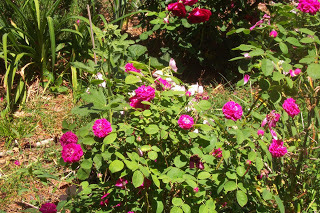 Although Portlands were only really popular for a brief period in the early years of the 19thcentury before Bourbon and Hybrid Perpetuals overshadowed them, they are still excellent garden additions.
Although Portlands were only really popular for a brief period in the early years of the 19thcentury before Bourbon and Hybrid Perpetuals overshadowed them, they are still excellent garden additions. The Portland class is a small group of roses, only a few dozen were hybridized during the 19th century and none in the 20th or 21st. They are very winter hardy, however, and are very strong rebloomers.
Most Portlands show some of the same characteristics as the Damasks, except they are generally shorter. And of course, unlike Damasks, Portlands rebloom.
Characteristics include:v Moderate size, most are around 4’ tall, making them good garden additions where there is not a lot of room.v The flowers have very short stems with leaves growing around the flower. Graham Thomas describes this as a rosette or shoulder of leaves.v Flowers repeat fairly reliably.v Portlands have a rich, strong Damask rose fragrance.v Disease resistance is quite good.
Some good varieties include:
v ‘Comte de Chambord’, introduced 1860 by Moreau-Robert (France). An extremely popular rose, even today. The flowers are very full, quartered, in a clear pink with an extremely powerful Damask rose fragrance. This is a strong grower and forms an upright shrub around 4’ tall with lots of foliage. Repeat flowering.
v ‘Indigo’, circa 1830. Forms a compact bush around 4’ tall with dark green foliage. The flowers are large, with a lovely dark purple hue.
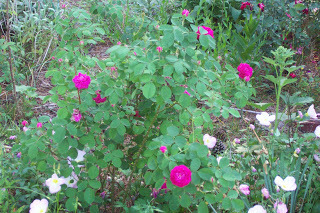
v ‘Rose de Rescht’ was brought to Englandby Miss Nancy Lindsay from Iranor France. This rose forms a bushy shrub that stays fairly small, approximately 3’ tall. Very double flowers have a purplish-crimson color and are fragrant. There is ample, rough-textured foliage, and it reliably produces at least two crops of flowers.
v ‘Marbrée’ was raised by Robert et Moreau in 1858, in France. The shrubs tend to grow to about 4’ tall with plentiful dark green foliage. The flowers are a deep purple-pink, mottled with pale pink. They open flat and have only a slight fragrance. These roses are generally free of disease.
v ‘The Portland Rose’ (the ‘Scarlet Four Seasons’ Rose’ according to David Austin). This rose is healthy and forms a spreading bush about 3’ tall. Blooms very well in both spring and fall. The flowers are semi-double in light crimson, and open wide to display yellow stamens. It is very fragrant.
Hope you enjoy the last few months and are preparing for the fall rose season. It can be a pretty spectacular way to end the summer. But if you need a cooling break from the summer heat, there's always a new book to be had...
A Rose Before Dying Kindle: http://www.amazon.com/dp/B00557U2QU/ Nook: http://www.barnesandnoble.com/w/a-rose-before-dying-amy-corwin/1103391099 Only Sir Edward had the motive and the opportunity.When the first victim dies, Sir Edward is the likeliest culprit. The murdered woman was Sir Edward’s ex-mistress who threw him over for a younger man, and she dies after receiving a mysterious rose. Confused and stricken by her death, Sir Edward is horrified when a second rose is delivered, along with a note insinuating that he had something to do with his mistress’ death. In desperation, he begs his nephew, Charles Vance, to help him prove his innocence.
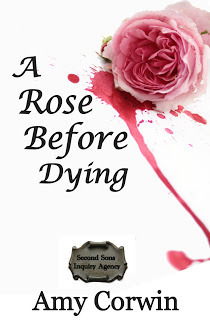 Charles Vance, the new Earl of Castlemoor, is convinced Sir Edward is innocent and agrees to work with the renowned head of the Second Sons Inquiry Agency to flush out the murderer. But the investigation soon reveals more reasons why Sir Edward may be responsible and even the inquiry agent warns Charles not to let family loyalty stand in the way of the truth. There may be some truth behind the rumors. "The roses may simply be Sir Edward’s attempt to cast suspicion elsewhere." "Misdirection." Or so the whispers say.
Charles Vance, the new Earl of Castlemoor, is convinced Sir Edward is innocent and agrees to work with the renowned head of the Second Sons Inquiry Agency to flush out the murderer. But the investigation soon reveals more reasons why Sir Edward may be responsible and even the inquiry agent warns Charles not to let family loyalty stand in the way of the truth. There may be some truth behind the rumors. "The roses may simply be Sir Edward’s attempt to cast suspicion elsewhere." "Misdirection." Or so the whispers say.Desperate to stop the murders, Charles enlists the aide of notable rosarian, Ariadne Wellfleet, to identify the roses in hopes of saving the next victim. Unfortunately, his actions sweep the Wellfleet household into the killer’s net and puts friends and family alike at risk. He has no choice but to finish the investigation, regardless of the costs.
A Rose Before Dying is a witty Regency whodunit combined with a heart-warming romance in the tradition of Georgette Heyer’s The Masqueraders and Victoria Holt’s The Mistress of Mellyn. This addition to the Second Sons mystery series includes an unwilling detective whose family loyalties are tested as he seeks to catch an elusive killer.
Fiction Writing and Other Oddities
Published on August 25, 2012 08:29
August 8, 2012
Gardening in August
It’s hot—really hot—and the hardest thing this time of year seems to be keeping ahead of the weeding. The weeds seem to grow even without water or care, while the other flowers suffer as the weather reaches the highest temperatures. Last year, we had a drought, but this year, it's been raining every afternoon. That's terrific for my roses, but not so great on the weeding front as we're literally taken over by weeds. We are particularly plagued by pink purslane (Portulaca pilosa L.). It’s related to that wonderful and very colorful annual Portulaca (moss rose) and some folks have decided to stop trying to weed out purslane as it does have a lovely, bright hot pink flower about ½” across that opens during the day.
 You can see from this picture that it has reddish stems and less clearly, rather “succulent” leaves. This specimen is getting ready to bloom, but isn’t quite there yet.
You can see from this picture that it has reddish stems and less clearly, rather “succulent” leaves. This specimen is getting ready to bloom, but isn’t quite there yet.Some have been known to use purslane in salads as it contains more Omega-3 fatty acids than any other leafy vegetable. In antiquity, it was one of several pot herbs that “should be sown in April” according to Theophrastus (4th century BC). Pliny advised wearing it as an amulet to expel all evil due to its healing properties. It is known as Ma Chi Xian in China and has been used in traditional Chinese medicine for dysentery and topically to relieve skin abrasions or insect bites. However, it also contains oxalate, a compound implicated in the formation of kidney stones, so I personally do not include purslane in our diet, particularly since our variety of purslane is not the yellow-flowered variety one commonly uses in Europe in salads.
So you see, what is one man’s weed is another man’s sought-after herb.
 And it’s hot enough now that I’ve decided not to make any real attempt to eradicate purslane from our garden. I’m very fond of it growing over the edges of our brick walkway, so I think I won’t worry too much about pulling it out.
And it’s hot enough now that I’ve decided not to make any real attempt to eradicate purslane from our garden. I’m very fond of it growing over the edges of our brick walkway, so I think I won’t worry too much about pulling it out.This is, of course, the time of year when marigolds really come into their own. I’ve always loved marigolds and adore all the new varieties available. There is even an off-white one that is absolutely terrific as a “bridging” plant between the hot colors of late summer marigolds and the mums of fall, which often include rich rose and burgundy. And don’t forget the plants with colorful foliage like coleus that come in everything from lime green and white to deep burgundy. They can also be used effectively in planters and gardens. They are beautiful all summer, even when other plants have stopped blooming, since they are grown for their foliage. They do need to be pinched back, though, to keep them busy.
 Late July and August is also prime time for verbenas, as shown in this photo. The plans are blooming powerhouses and will attract hundreds of butterflies and hummingbirds. They come in a variety of colors, including delicate pinks as well as hot orange and pink combinations. If planted in good soil with the occasional watering, they will grow as high as your waist in one season. Folks in USDA gardening zones 7-10 will find verbenas will grow as perennials as long as you remember not to cut them back too far in the winter. The hollow stems will fill with water and freeze, thereby killing the plant, if you forget. Nonetheless, this is an extremely easy to grow plant that requires virtually no care and will survive if you forget to water for a few weeks.
Late July and August is also prime time for verbenas, as shown in this photo. The plans are blooming powerhouses and will attract hundreds of butterflies and hummingbirds. They come in a variety of colors, including delicate pinks as well as hot orange and pink combinations. If planted in good soil with the occasional watering, they will grow as high as your waist in one season. Folks in USDA gardening zones 7-10 will find verbenas will grow as perennials as long as you remember not to cut them back too far in the winter. The hollow stems will fill with water and freeze, thereby killing the plant, if you forget. Nonetheless, this is an extremely easy to grow plant that requires virtually no care and will survive if you forget to water for a few weeks.If you grow roses, don’t forget to water them and feed them to prepare for another glorious season of bloom in late August-September. Remove any hips (dead flowers) to encourage bloom production. Old wisdom said to clip off spent flower sprays down to the first 5-leafed leaflet. I simply pinch off the hip, leaving all leaves on the stem. Leaves are good—they are the energy factory for the plant—so the more leaves you can leave a plant, the better.
Hope you are enjoying your summer garden!
Stay cool in the dog days of summer and don’t worry if you let a few weeds intrude. Just tell anyone who comments that they are an herb you meant to grow there.
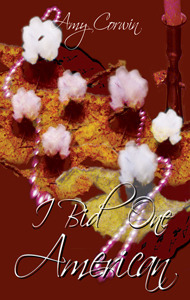 Finally, although the nearby cotton field has another month to go before the cotton "balls" form, this time of year always reminds me of my second Archer family Regency romance, I Bid One American. The heroine is a "fish out of water" as an American heiress living in London. If you want a light, funny read with a touch of mystery, you might check it out. And yes, those white things on the cover are cotton...Fiction Writing and Other Oddities
Finally, although the nearby cotton field has another month to go before the cotton "balls" form, this time of year always reminds me of my second Archer family Regency romance, I Bid One American. The heroine is a "fish out of water" as an American heiress living in London. If you want a light, funny read with a touch of mystery, you might check it out. And yes, those white things on the cover are cotton...Fiction Writing and Other Oddities
Published on August 08, 2012 07:30
August 2, 2012
Thinking About the Fall
Most of you are probably wondering why I suddenly diverged from writing about writing, books, history and those types of things to gardening. The fact is, I love gardening almost as much as writing, so I thought I'd share some of the information I've gathered over the years. There is also the odd circumstance that my rose gardening and researching roses led me to set some of my mysteries (A Rose Before Dying, Smuggled Rose, and The Necklace, to name a few) in the period when rose gardening really started coming into its own (early years of the 19th century).
Although we are firmly in the middle of summer, it will only be a few weeks before the weather starts cooling off. That means, now is a good time to line up and even order plants or seeds you want to plant in the fall.
Which brings me to the real subject of this blog: Fall Rose Planting. :) You knew I'd get there, one way or the other, right?
Fall is a Great Time to Order Roses
Fall is a wonderful time to order and plant roses. As the weather cools, you can start thinking about what new roses you’d like to see blooming in the spring. By ordering--and planting--in the fall, you give your roses a chance to “dig in” and get settled over the winter in their new location. When spring arrives, they will be ready to put on a wonderful show for you.
In North Carolina, fall planting has an additional benefit in that we often start getting a great deal more rainfall. This rain and the cooler weather will help your roses put down good roots to support extra blooms when the weather warms up in March and April.
If you’re considering taking this advice, there is a new category of “Earth Kind Roses” that Texas A&M University has been using to designate roses which stand up to insects, widely varying soil conditions, and minimal care. The program has been used to find roses which can be used in areas, such as between roadways, where they will have to survive with very little cosseting.
A few of the roses identified as EarthKind follow. They span a range of rose classifications and there are sure to be some which would do very well in your garden.
Belinda’s Dream: Shrub rose with medium pink, very double flowers. ARS rating of 8.4Caldwell Pink: Polyantha rose with lilac pink flowers, height up to 4’.Else Poulsen: Floribunda, medium pink, semi-double with 10 petals. ARS rating of 8.1.Katy Road Pink: Also called Carefree Beauty, Shrub rose with medium pink blooms of 15-20 petals. ARS rating of 8.7.Knock Out: Shrub with blooms that are a red blend, single flowers. ARS rating of 8.6.Marie Daly: Polyantha rose in medium pink with an ARS rating of 7.6.Mutabilis: Hybrid China rose with single flowers (5 petals) that start out pale yellow and age through pink to deep rose. ARS rating of 8.9.Perle d’Or: Polyantha rose with double flowers that are a yellow blend. ARS rating of 8.4.Sea Foam: Shrub rose with white flowers which are double ARS rating of 8.1.The Fairy: Polyantha rose with light pink, double blooms. It has some (slight) fragrance. ARS rating of 8.7.
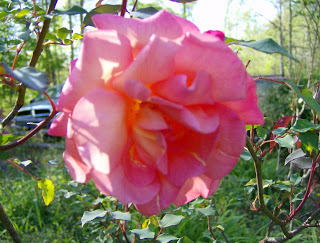 The list of EarthKind roses has been expanding recently to include the following roses, as well:
The list of EarthKind roses has been expanding recently to include the following roses, as well:
Cecile Brunner: Polyantha with double, light pink flowers. ARS rating of 8.4.Comtesse du Cayla: Hybrid China rose with semi-double blooms that are an orange and pink blend. [Picture on the left.] ARS rating of 7.0.Duchesse de Brabant: Tea rose with light pink flowers consisting of approximately 45 petals. ARS rating of 8.6.Marchesa Boccella: Hybrid Perpetual rose with light pink blooms that are very fragrant. ARS rating of 9.1.Marie Pavie: Polyantha rose with white flowers which are double. ARS rating of 8.9.Mrs. Dudley Cross: Tea rose with double flowers in a yellow and pink blend. ARS rating of 8.3. In North Carolina, this rose can grow into a very large and well-formed bush, about 6’ by 6’.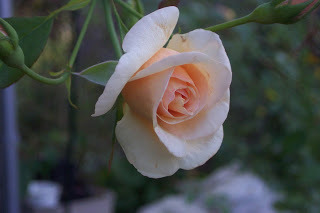 Reve d’Or: Noisette rose (that in my personal experience can very well take over a small building in one season). The blooms are pale yellow and double. [Picture on the right.] It has an ARS rating of 9.4.Souvenir de St. Anne’s: Bourbon rose with light pink, fragrant blooms.Spice: China rose classified as an Old Garden Rose. Spice is blush pink and is very fragrant. It grows from 3 to 5’ in height.
Reve d’Or: Noisette rose (that in my personal experience can very well take over a small building in one season). The blooms are pale yellow and double. [Picture on the right.] It has an ARS rating of 9.4.Souvenir de St. Anne’s: Bourbon rose with light pink, fragrant blooms.Spice: China rose classified as an Old Garden Rose. Spice is blush pink and is very fragrant. It grows from 3 to 5’ in height.
Roses Unlimited is a great source for "Earth Kind" roses, so I hope you'll check them out.
Planting Roses
Planting roses in the fall is really not much different from planting in the spring, except you do want to ensure you use a good, thick coat of mulch.
Select a site which has both good air circulation and at least six hours of sunshine. There are a few roses, such as Rambling Rector which will grow into trees and can withstand some shade, but they are the exception and even they will do better with more sunshine!
Make sure you prepare your beds while you wait for your roses to be delivered. It is never too soon to prepare a bed since having good soil is a key element to healthy roses. If you can, get the Agriculture Extension Office to test some soil samples to make sure you use the proper amendments. Good drainage is critical. No roses like to stand in water. If you have clay or slow-draining soil, you can add organic matter and gypsum to help condition the soil.
When you get your roses, be sure to water them well. Dig a hole twice as deep and twice as wide as the container in which they are growing. Plant your roses at the same depth in the ground as they were in their container.
After you dig the hole, mix the soil you removed fifty/fifty with organic matter and soil conditioners, such as alfalfa meal or cottonseed meal and gypsum. You can also use the fine, bark-like soil conditioners to break up clay soil.
Trim back any broken or damaged stems, but leave healthy leaves if you plant before November.
Top dress with three to four inches of mulch to allow for good drainage, moisture retention, and weed control.
Once your roses are planted, don’t forget to water them (unless the winter rains have already begun, in which case you can sit back and relax). Water deeply at least once a week; two to three inches of water is recommended. Try not to get the leaves wet when you water, particularly in the fall as the cooler nights can promote diseases such as black spot.
You will not need to fertilize your roses in the fall, that task can wait until spring.
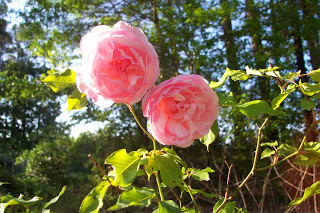 Duchesse de Brabant, a Tea rose and one of the EarthKind roses that do well in the North Carolina area. “No spraying required!” [Picture on the left.]
Duchesse de Brabant, a Tea rose and one of the EarthKind roses that do well in the North Carolina area. “No spraying required!” [Picture on the left.]
Interestingly enough, Duchesse de Brabant was one of Teddy Roosevelt’s favorite roses, and he frequently wore a bloom from this wonderful rose in his lapel.
Fiction Writing and Other Oddities
Although we are firmly in the middle of summer, it will only be a few weeks before the weather starts cooling off. That means, now is a good time to line up and even order plants or seeds you want to plant in the fall.
Which brings me to the real subject of this blog: Fall Rose Planting. :) You knew I'd get there, one way or the other, right?
Fall is a Great Time to Order Roses
Fall is a wonderful time to order and plant roses. As the weather cools, you can start thinking about what new roses you’d like to see blooming in the spring. By ordering--and planting--in the fall, you give your roses a chance to “dig in” and get settled over the winter in their new location. When spring arrives, they will be ready to put on a wonderful show for you.
In North Carolina, fall planting has an additional benefit in that we often start getting a great deal more rainfall. This rain and the cooler weather will help your roses put down good roots to support extra blooms when the weather warms up in March and April.
If you’re considering taking this advice, there is a new category of “Earth Kind Roses” that Texas A&M University has been using to designate roses which stand up to insects, widely varying soil conditions, and minimal care. The program has been used to find roses which can be used in areas, such as between roadways, where they will have to survive with very little cosseting.
A few of the roses identified as EarthKind follow. They span a range of rose classifications and there are sure to be some which would do very well in your garden.
Belinda’s Dream: Shrub rose with medium pink, very double flowers. ARS rating of 8.4Caldwell Pink: Polyantha rose with lilac pink flowers, height up to 4’.Else Poulsen: Floribunda, medium pink, semi-double with 10 petals. ARS rating of 8.1.Katy Road Pink: Also called Carefree Beauty, Shrub rose with medium pink blooms of 15-20 petals. ARS rating of 8.7.Knock Out: Shrub with blooms that are a red blend, single flowers. ARS rating of 8.6.Marie Daly: Polyantha rose in medium pink with an ARS rating of 7.6.Mutabilis: Hybrid China rose with single flowers (5 petals) that start out pale yellow and age through pink to deep rose. ARS rating of 8.9.Perle d’Or: Polyantha rose with double flowers that are a yellow blend. ARS rating of 8.4.Sea Foam: Shrub rose with white flowers which are double ARS rating of 8.1.The Fairy: Polyantha rose with light pink, double blooms. It has some (slight) fragrance. ARS rating of 8.7.
 The list of EarthKind roses has been expanding recently to include the following roses, as well:
The list of EarthKind roses has been expanding recently to include the following roses, as well:Cecile Brunner: Polyantha with double, light pink flowers. ARS rating of 8.4.Comtesse du Cayla: Hybrid China rose with semi-double blooms that are an orange and pink blend. [Picture on the left.] ARS rating of 7.0.Duchesse de Brabant: Tea rose with light pink flowers consisting of approximately 45 petals. ARS rating of 8.6.Marchesa Boccella: Hybrid Perpetual rose with light pink blooms that are very fragrant. ARS rating of 9.1.Marie Pavie: Polyantha rose with white flowers which are double. ARS rating of 8.9.Mrs. Dudley Cross: Tea rose with double flowers in a yellow and pink blend. ARS rating of 8.3. In North Carolina, this rose can grow into a very large and well-formed bush, about 6’ by 6’.
 Reve d’Or: Noisette rose (that in my personal experience can very well take over a small building in one season). The blooms are pale yellow and double. [Picture on the right.] It has an ARS rating of 9.4.Souvenir de St. Anne’s: Bourbon rose with light pink, fragrant blooms.Spice: China rose classified as an Old Garden Rose. Spice is blush pink and is very fragrant. It grows from 3 to 5’ in height.
Reve d’Or: Noisette rose (that in my personal experience can very well take over a small building in one season). The blooms are pale yellow and double. [Picture on the right.] It has an ARS rating of 9.4.Souvenir de St. Anne’s: Bourbon rose with light pink, fragrant blooms.Spice: China rose classified as an Old Garden Rose. Spice is blush pink and is very fragrant. It grows from 3 to 5’ in height.Roses Unlimited is a great source for "Earth Kind" roses, so I hope you'll check them out.
Planting Roses
Planting roses in the fall is really not much different from planting in the spring, except you do want to ensure you use a good, thick coat of mulch.
Select a site which has both good air circulation and at least six hours of sunshine. There are a few roses, such as Rambling Rector which will grow into trees and can withstand some shade, but they are the exception and even they will do better with more sunshine!
Make sure you prepare your beds while you wait for your roses to be delivered. It is never too soon to prepare a bed since having good soil is a key element to healthy roses. If you can, get the Agriculture Extension Office to test some soil samples to make sure you use the proper amendments. Good drainage is critical. No roses like to stand in water. If you have clay or slow-draining soil, you can add organic matter and gypsum to help condition the soil.
When you get your roses, be sure to water them well. Dig a hole twice as deep and twice as wide as the container in which they are growing. Plant your roses at the same depth in the ground as they were in their container.
After you dig the hole, mix the soil you removed fifty/fifty with organic matter and soil conditioners, such as alfalfa meal or cottonseed meal and gypsum. You can also use the fine, bark-like soil conditioners to break up clay soil.
Trim back any broken or damaged stems, but leave healthy leaves if you plant before November.
Top dress with three to four inches of mulch to allow for good drainage, moisture retention, and weed control.
Once your roses are planted, don’t forget to water them (unless the winter rains have already begun, in which case you can sit back and relax). Water deeply at least once a week; two to three inches of water is recommended. Try not to get the leaves wet when you water, particularly in the fall as the cooler nights can promote diseases such as black spot.
You will not need to fertilize your roses in the fall, that task can wait until spring.
 Duchesse de Brabant, a Tea rose and one of the EarthKind roses that do well in the North Carolina area. “No spraying required!” [Picture on the left.]
Duchesse de Brabant, a Tea rose and one of the EarthKind roses that do well in the North Carolina area. “No spraying required!” [Picture on the left.]Interestingly enough, Duchesse de Brabant was one of Teddy Roosevelt’s favorite roses, and he frequently wore a bloom from this wonderful rose in his lapel.
Fiction Writing and Other Oddities
Published on August 02, 2012 09:25
July 26, 2012
Alba Roses - Fragrant Old Garden Roses
Old Garden Roses - Alba
I thought I would continue writing a few blogs about one of my favorite plants: roses. Some of you may have already noted this obsession of mine, considering some of my books such as Smuggled Rose or A Rose Before Dying so this blog shouldn't really be a surprise. I do love roses and history.
So here you are...a short article about Alba roses.
Alba roses are classed with the Old Garden Roses (OGR), which are generally considered to be roses hybridized or introduced prior to 1900. The 1900’s marked the beginning of the era of the Hybrid Teas, which are the most popular roses today. OGR’s have been around this long simply because they are worth growing and are survivors. The majority are intensely fragrant and extremely attractive when in full bloom, and the Alba roses are no exception.
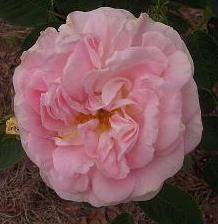 Alba roses are extremely ancient and during medieval times, the white roses were often associated with the Virgin Mary. Many rose historians speculate that the Alba rose class arose from crosses between wild Dog roses and ancient Damasks (which will be covered in the third article).
Alba roses are extremely ancient and during medieval times, the white roses were often associated with the Virgin Mary. Many rose historians speculate that the Alba rose class arose from crosses between wild Dog roses and ancient Damasks (which will be covered in the third article).The Alba class of roses are fairly large shrubs with bluish gray leaves and white or pale pink flowers. Albas bloom once, generally in summer, and are wonderfully fragrant. The entire bush can be covered with blossoms during the flowering period and will fill the air with their heady perfume.
They do not need to be sprayed and do not suffer from blackspot. They are, in fact, one of the toughest and easiest of all the roses to grow. They are extremely tolerant of imperfect growing conditions including: bad soil, light shade, and insufficient water. However, if you live in the hot and humid South, Albas do struggle in that climate and seem to prefer cooler climes.
The most common characteristics of the class are:Thorny stems.Soft, bluish gray leaves.Buds are long and graceful, with long sepals.The bushes are generally quite large (average 7’ tall).Somewhat shade tolerant.Colors range from white through light pink.They require no pruning and will flower well, year after year, by only removing the dead wood.
A few Alba roses include:
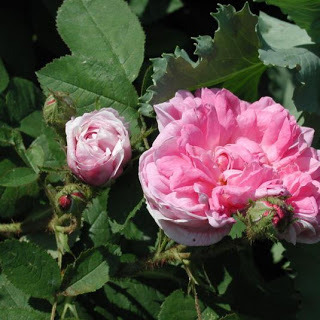 ‘Great Maiden’s Blush’ ancient. This is one of my favorite roses and is a gorgeous soft pink. The shrub can reach almost 8 feet and will sucker if grown on its own roots. The glorious flowers are very double with pale pink outside petals with a deeper pink in the center. The flower will gradually fade to white as it ages. Very rich fragrance.
‘Great Maiden’s Blush’ ancient. This is one of my favorite roses and is a gorgeous soft pink. The shrub can reach almost 8 feet and will sucker if grown on its own roots. The glorious flowers are very double with pale pink outside petals with a deeper pink in the center. The flower will gradually fade to white as it ages. Very rich fragrance. Rosa alba ‘Semiplena’ ancient. ‘Semiplena’ is another large shrub, known to grow up to 8 feet tall. It has pure white flowers, semi-double, with a rich scent. It has been grown frequently in place of Damask roses, to produce Attar of Roses. It will grow even in partial shade.
‘Jacobite Rose’(aka Rosa alba ‘Maxima’) – ancient origin. Rosa alba ‘Maxima’ can grow up to 7 feet tall, with graceful, arching branches. The flowers are pure white and some may have a touch of pink in the center. Good fragrance
‘Céleste’late 18th century. It reaches 7’ tall and sports semi-double flowers in rose pink color with gold stamens. The roses are particularly delicate in appearance and have an interesting elongated, slender bud. The flowers are exceptionally fragrant.
‘Félicité Parmentier’ known since 1834. This Alba is one of the shorter, and therefore more useful shrubs that reaches 4’. It has double flowers in pale pink set off by a green button eye. Good fragrance.
‘Mme Plantier’ Plantier, 1835. ‘Mme Plantier’ is another tall shrub which can even be trained as a small climber (approx. 8-9’). It has lovely double flowers in creamy white. The buds are red-tinted prior to opening. As with the other Albas, this one has a good scent.
These are just a few varieties. All the Alba roses are well worth the garden space and require minimal to perform exceptionally well. They aren't that easy to find, but Pickering Nursery is a good source for these and many other OGR.
Happy Gardening!
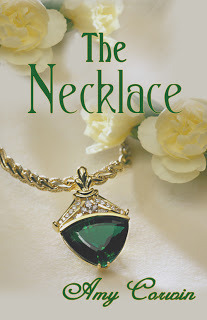 And speaking of gardening...Oriana Archer in the first of the Regency series of books about the adventures of the Archer family is also a fanatical gardener. (Hmmm, wonder how that happened?) If you want to find out more about her and the cursed family necklace she discovers, check out
The Necklace
.
And speaking of gardening...Oriana Archer in the first of the Regency series of books about the adventures of the Archer family is also a fanatical gardener. (Hmmm, wonder how that happened?) If you want to find out more about her and the cursed family necklace she discovers, check out
The Necklace
.Fiction Writing and Other Oddities
Published on July 26, 2012 05:50
July 19, 2012
Growing Roses Organically
Organic Rose GardeningBucking Conventional Wisdom and Doing the ImpossibleA lot of folks have expressed an interest in converting their garden over to a more organic approach to user fewer pesticides or other chemicals. I’ve been doing this for some time now and have learned a few lessons--the hard and very expensive way--so I thought it might be worthwhile to share.
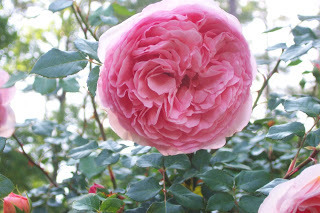 My main focus here is on roses, but most of the hints are also useful to all kinds of gardens, including vegetable gardens.
My main focus here is on roses, but most of the hints are also useful to all kinds of gardens, including vegetable gardens.Why grow roses organically? There are a lot of reasons. My own included the following:Our well, which supplies the water we drink, is right dead center in the garden. I don’t particularly want to drink the stuff folks spray on roses.We are an official National Wildlife Federation Habitat which means we provide food, water and shelter for birds and small animals. I don’t want to endanger the wildlife nesting in our roses by spraying them right in the middle of breeding and nesting season (spring/early summer).I travel for work so I’m frequently gone for a week at a time and don’t have a lot of time to spend spraying.Our dogs have been known to eat our roses. In the fall, they eat the hips they can reach. I’d rather not poison them, if I can help it.We occasionally eat the roses and hips. Rose hip jelly tastes a lot like apple jelly and is a good source of vitamin C. I also like sugared rose petals on yellow cake, or rose petals sprinkled in a salad made of fresh spinach leaves, mandarin oranges, toasted almonds, spring onions and a red wine vinaigrette dressing. Mmmmm, tasty.
So now that you know a few excuses (other than I’m lazy and don’t feel like spraying) let’s discuss how to actually accomplish this and still have a fairly nice garden. This is possible, despite black spot and our hot, humid summers in the south-eastern-most tip of North Carolina, but it does take a little compromise.
Step 1: Buy Liz Druitt’s book, The Organic Rose Garden. It is written for southern gardeners and is one of the best resources I’ve found on organic rose gardening. It is a superb little book.
Step 2: Your roses will need a really good home if they are to survive organically. This means lots of water, a decent bed rich with organics, plenty of mulch, at least six hours of sunshine a day, and no root competition.
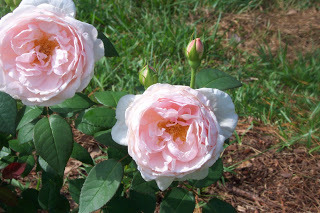 The number one reason why organic rose gardens fail is that the roses are simply not given a good home. They are struggling in the shade of some huge tree, competing for water and food, and don’t get enough sun. If you correct this situation, a lot of roses (and other sun loving plants like veggies) can be grown organically and will shrug off black spot as if it is nothing.
The number one reason why organic rose gardens fail is that the roses are simply not given a good home. They are struggling in the shade of some huge tree, competing for water and food, and don’t get enough sun. If you correct this situation, a lot of roses (and other sun loving plants like veggies) can be grown organically and will shrug off black spot as if it is nothing.Step 3: Don’t plan on growing a lot of Hybrid Teas. You are lucky to be living today when we have David Austin’s beautiful English (shrub) roses which are remontant (reblooming) and can easily take the place of the Hybrid Tea roses. There are also the Old Garden Roses, some of which cannot be sprayed or they will not do well.
There is a list of roses at the end of this article which I have successfully grown organically in this area.
Now for the nitty-gritty...Going organic doesn’t necessarily mean not spraying at all. If you have roses that suffer black spot, you can reduce it using organic methods.
Black SpotOrganic methods will not provide a cure for black spot, so get over the idea.
What you can do is try to prevent it, or reduce it.
Here are the basic steps to take to reduce black spot.Remove all leaf litter from the roses in the winter (this should include infected leaves which dropped last summer.)Spray with a dormant oil. Yes. This is considered “legal” if you are doing organic gardening.Provide a thick layer of mulch.During the growing season, pluck badly infected leaves off the roses to remove the source(s) of infection.Provide enough water. Water, water, water. Make sure the water is on the ground, not on the rose’s leaves if you water in the evening.Spray with a mixture of 1Tbsp Baking Soda per gallon of water, plus horticultural oil. In the summer, you can spray with just the 1Tbsp Baking Soda per gallon of water, but do it in the morning. This mixture will kill new spores, which will help prevent infection, but won’t kill existing infection.Keep the bed heavily mulched. We use pine straw. Anything, including grass clipping, will work. Just note that if you add grass clipping, you will need to add a source of nitrogen because decomposition will temporarily rob your roses of nitrogen while the clippings decay.
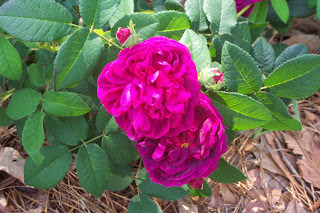 Planting· Dig a hole twice as wide and twice as deepas the container of the plant you are planting. For most roses, dig a hole 36 inches wide and 20 inches deep. · Mix the dirt as follows This “recipe” is built around our soil which is gray clay, acidic, and lacks almost all nutrients. We basically have to build the soil. I prefer to create the bed with this stuff in December/January, let it sit for a month or two, and then plant roses in it during February.o 1/3 - 1/2 of the top dirt dug from the hole (move the bottom-most dirt aside)o Several cups of Gypsumo 1-2 cups of Lime (I need this, you may not, depending upon the acidity of your soil)o 1/2 cup Epson Saltso 3-4 cups of Cotton Seed Meal (Alfalfa Meal is better, but occasionally hard to get)o 1 bag of soil amendment (looks like finely shredded bark)o 1 bag of mushroom composto 2 cups sharp sandYou can add any other soil conditioners you need. Ones I like to include occasionally are: Kelp Meal, Bone Meal, Blood Meal, etc. If you have a source for horse manure, marry them or at least get heavily involved so that you can get a constant supply. If all else fails, pay the guy to deliver in the fall and spring. Or start raising dwarf horses.
Planting· Dig a hole twice as wide and twice as deepas the container of the plant you are planting. For most roses, dig a hole 36 inches wide and 20 inches deep. · Mix the dirt as follows This “recipe” is built around our soil which is gray clay, acidic, and lacks almost all nutrients. We basically have to build the soil. I prefer to create the bed with this stuff in December/January, let it sit for a month or two, and then plant roses in it during February.o 1/3 - 1/2 of the top dirt dug from the hole (move the bottom-most dirt aside)o Several cups of Gypsumo 1-2 cups of Lime (I need this, you may not, depending upon the acidity of your soil)o 1/2 cup Epson Saltso 3-4 cups of Cotton Seed Meal (Alfalfa Meal is better, but occasionally hard to get)o 1 bag of soil amendment (looks like finely shredded bark)o 1 bag of mushroom composto 2 cups sharp sandYou can add any other soil conditioners you need. Ones I like to include occasionally are: Kelp Meal, Bone Meal, Blood Meal, etc. If you have a source for horse manure, marry them or at least get heavily involved so that you can get a constant supply. If all else fails, pay the guy to deliver in the fall and spring. Or start raising dwarf horses.Now that you are ready...Once you have prepared your beds for your roses and are ready to take the plunge, you will need to purchase some roses, or at least acquire some which stand a good chance of survival.
Personally, I prefer own-root roses, so I buy almost exclusively from two sources: Roses Unlimited and Chamblee’s. Chamblee’s in particular is my first choice since they are about half the price of everyone else.
I’ve never had a rose from either of these sources die on me. They are sent in large pots and the roses are always in good shape.
Here are varieties I have had very good success with and seem to have very little problem with disease. I have focuses mostly on remontant varieties, rather than listing the once blooming Old Garden Roses. Bourbons Souvenir de la Malmaison This rose stays short-3’ tall, never needs to be trimmed, blooms constantly, and has exquisite blooms in pale pink. Very fragrant. It is particularly disease-resistant. Noisettes Reve d’OhrThis is a HUGE rose, so be warned. It is a good climber. It will take over any support unless you keep it trimmed back. Beautiful pale, buffy yellow flowers. Blooms constantly. Very disease-resistant. Tea Marie Van HoutteVery large shrub (6’x6’) with beautiful creamy white flowers that age to pink. Blooms constantly. Very disease-resistant.Duchesse de BrabantThis rose stays fairly compact-4’ tall, never needs to be trimmed, blooms constantly, and has exquisite blooms in medium pink. The flowers are shaped rather like a tulip. Very disease resistant. This was one of Teddy Roosevelt’s favorite roses and he often wore one on his lapel. English Wise PortiaSmall, tidy bush. Stays about 3’ tall and never needs to be trimmed. Gorgeous deep magenta flowers. Blooms constantly. This is a wonderful rose paired with Souvenir de la Malmaison.
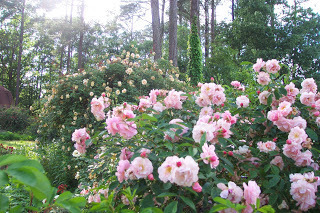 Lilian AustinCoral blend, loosely double flowers. Blooms constantly. The form stays short, but it “weeps”. If you have the room for it to sprawl, it is lovely left as a loose fountain shape. Otherwise, you can trim back the flexible shoots.Wife of BathThis rose stays short-3’ tall, never needs to be trimmed, blooms constantly, and has exquisite blooms in pale pink. Very fragrant. It is very similar to Souvenir de la Malmaison, except the flowers are smaller.Noble AntonySmall, tidy bush. Stays about 3’ tall and never needs to be trimmed. Gorgeous magenta-red flowers. Blooms constantly. St. SwithunPale pink globular flowers. Blooms constantly. The form stays medium height, but it “weeps”. If you have the room for it to sprawl, it is lovely left as a loose fountain shape. Otherwise, you can trim back the flexible shoots.
Climber
DortmundSingle blooms in fire-engine red with a white center. Glossy green leaves. Large clusters of blooms. Blooms continuously. Extremely disease-resistant.
Lilian AustinCoral blend, loosely double flowers. Blooms constantly. The form stays short, but it “weeps”. If you have the room for it to sprawl, it is lovely left as a loose fountain shape. Otherwise, you can trim back the flexible shoots.Wife of BathThis rose stays short-3’ tall, never needs to be trimmed, blooms constantly, and has exquisite blooms in pale pink. Very fragrant. It is very similar to Souvenir de la Malmaison, except the flowers are smaller.Noble AntonySmall, tidy bush. Stays about 3’ tall and never needs to be trimmed. Gorgeous magenta-red flowers. Blooms constantly. St. SwithunPale pink globular flowers. Blooms constantly. The form stays medium height, but it “weeps”. If you have the room for it to sprawl, it is lovely left as a loose fountain shape. Otherwise, you can trim back the flexible shoots.
Climber
DortmundSingle blooms in fire-engine red with a white center. Glossy green leaves. Large clusters of blooms. Blooms continuously. Extremely disease-resistant.And of course, the Gallica as well as many others of the Old Garden Rose classes do not require spraying and are resistant to black spot. My favorite Gallica is currently sold as ‘Sissinghurst Castle’ and looks exactly like a crumpled piece of deep magenta-purple velvet.
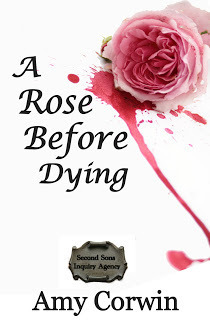 Good luck and I hope you have success with your rose garden in the coming year.
Good luck and I hope you have success with your rose garden in the coming year.And of course, I have to mention that in my Regency mystery, A Rose Before Dying, Ariadne grows all her roses organically.
Fiction Writing and Other Oddities
Published on July 19, 2012 08:42
July 9, 2012
It's Summer and Time for Roses
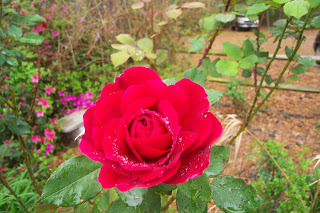
Hybrid Tea Roses
I can't resist writing about roses, as you probably figured out in my last blog. :) Gardening is the best way I know to relax and yet accomplish something while your mind broods over your latest novel and what twists you can possibly feed into your story.
This time, I thought I would talk about the Queen of the rose shows: Hybrid Teas.
So...Hybrid Tea roses. These are the classic rose most people today think of when they hear the word ‘rose’. They are also sometimes called Large-flowered Roses. It’s the rose you get for your sweetheart from the florist, and it’s the rose that wins the awards of Queen, King and Princess in rose shows. There is a wide variety of color in this rose class, every color except true blue and black, and they all have large, stiffly petaled flowers and very long stems. They have been the most popular class of rose for over a hundred years because of their ability to rebloom through the spring, summer and fall season.
The first Hybrid Tea Rose is considered to be ‘La France’ which was introduced in 1867 by Guillot, a Lyons-based firm in France. The parentage is not documented, but it is thought to be a cross between a Hybrid Perpetual and a Tea Rose. Interestingly, this rose was classed as a Hybrid Perpetual for many years until the newer Hybrid Tea nomenclature caught on.
Initial Hybrid Teas were created by crossing Hybrid Perpetuals with Tea Roses until the twentieth century when more and more Hybrid Teas were simply crossed with other Hybrid Teas to form new roses.
Because this is such a large class of roses with more being bred every day, it is nearly impossible to provide an adequate description of the class since growth, foliage, bloom form, color and fragrance all differ from rose to rose. With the exception of the 5-petaled single form of the Hybrid Tea, most are high-pointed “florist” roses and generally considered their most beautiful in the half-opened stage of the blossom. This is in direct contrast to older roses which are most beautiful when fully opened.
However, it is still fairly safe to provide the following list of characteristics.
{ Blooms are carried on long stems, often with a single bloom at the end of the stem.{ Roses have high-pointed centers with large, thick petals.{ New growth is often reddish tinged.{ Roses rebloom fairly well (thanks to their China forbearers).{ Colors include the full spectrum of whites, pinks, red, purple, mauve, yellow, orange, with a variety of blends. The only colors not available are true blue and black.{ Disease resistance varies from highly susceptible to black spot and mildew to very disease resistant.{ Size varies from small bushes up to large climbing forms.{ Fragrance varies from none to a rich rose perfume.
There are a great many Hybrid Tea Roses to chose from and some are even quite healthy when grown organically without sprays.
A small selection of Hybrid Tea Roses that are healthy and can be grown with organic gardening methods include the following.
{ ‘Dainty Bess’ is a silvery pink, single rose (5 petals) with beautiful deep red stamens. It grows between 3-4’ tall and has a slight fragrance.{ ‘Peace’ is a famous rose brought to market after WWII. It’s a beautiful blend of yellow with pink edges and is fragrant.{ ‘La France’ is the rose that started it all, and it is still an excellent garden plant. The blooms are soft, silvery pink and it is fragrant.{ ‘Mister Lincoln’ is a reliable, dark red rose with a good fragrance and excellent health. It is also widely available.
Newer varieties include:{ ‘Gemini’ which is a pink blend and rated 8.2/very good by the American Rose Society.{ ‘Moonstone’, a white rose also rated 8.2.{ ‘Touch of Class’, an orange pink rose with a great rating of 9.0.
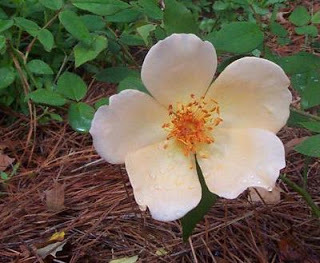 ‘Mrs. Oakley Fisher’
‘Mrs. Oakley Fisher’When you have bought a few more roses and planted them all, what should you do? Why, read a book! And if you're a fan of light Regency romances with a bit of humor and mystery, you can settle down with Escaping Notice, the latest in the Archer family series.
 Escaping Notice
Discarded by his betrothed with a parting sally that “being an earl does not excuse being a bore,” Hugh Castle, the Earl of Monnow, joins his brother on a relaxing cruise, hoping to forget. But a storm capsizes their boat, and despite Hugh’s desperate efforts, he can’t save his brother’s life. Then, when the wreckage reveals evidence of sabotage, he realizes he was never meant to return to dock. Someone intending to murder the earl killed his younger brother, instead. Angered and grieving, Hugh travels to London to enlist the aid of the Second Sons Inquiry Agency in finding his brother’s murderer.
Escaping Notice
Discarded by his betrothed with a parting sally that “being an earl does not excuse being a bore,” Hugh Castle, the Earl of Monnow, joins his brother on a relaxing cruise, hoping to forget. But a storm capsizes their boat, and despite Hugh’s desperate efforts, he can’t save his brother’s life. Then, when the wreckage reveals evidence of sabotage, he realizes he was never meant to return to dock. Someone intending to murder the earl killed his younger brother, instead. Angered and grieving, Hugh travels to London to enlist the aid of the Second Sons Inquiry Agency in finding his brother’s murderer.Helen Archer attended the Earl of Monnow’s ball in expectation of joining the celebration for his betrothal, but the event seems destined for disaster. She arrives late, the earl makes no announcement, and Helen manages to lose the fabled (but cursed) Peckham necklace her sister reluctantly loaned to her. Unwilling to admit her carelessness to her sister, Helen rashly decides to return to the earl’s estate and retrieve it in secret.
When his aunt threatens to send him to the Earl of Monnow, his purportedly cruel uncle, Edward Leigh-Brown decides he’s had enough of female interference. He’s going to join the navy and follow in Lord Nelson’s footsteps to become a military hero. But finding his way to London is a lot harder for a young boy than it seems, and he’s soon lost. When he bumps into Miss Helen Archer at an inn, he’s more than happy to accept a ride in her carriage, even if she seems determined to escort him to an inquiry agency to hire someone to locate the family he doesn’t want located.
When the three meet in London at Second Sons, Helen impulsively decides to accompany Hugh to the earl’s home. They will be disguised as servants and free to pursue their secret goals. Hugh hopes to uncover a killer, Helen hopes to find her necklace, and Edward just hopes he can find the opportunity to escape again.
But they are soon engulfed in an adventure none of them anticipated, and Hugh must hurry to identify who wants him dead before their deception ends in the death of another innocent.
Fiction Writing and Other Oddities
Published on July 09, 2012 06:01
June 26, 2012
Roses and History
And now for something completely different...Roses!
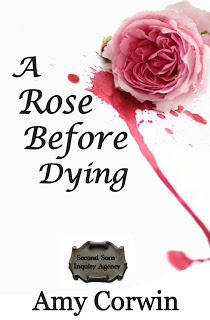 When I'm not writing books, I'm gardening, and somehow or other, I stumbled into roses. Ouch. When I started growing roses, I discovered the old garden varieties grew best for me and I became increasingly intrigued by the history of roses. In fact, I became so engrossed in roses that I even included them in several of my books, including
Smuggled Rose
and A Rose Before Dying.
When I'm not writing books, I'm gardening, and somehow or other, I stumbled into roses. Ouch. When I started growing roses, I discovered the old garden varieties grew best for me and I became increasingly intrigued by the history of roses. In fact, I became so engrossed in roses that I even included them in several of my books, including
Smuggled Rose
and A Rose Before Dying.Below are some of my notes about roses and their fascinating history. I hope you enjoy it and perhaps discover a few old garden roses you'd like to try out in your garden.
Historical Tidbits
ANCIENT TIMESI'm not the only one fascinated by roses. This flower has been described, and treatises written about how to grow roses by many ancient writers, including: · The Greek, Theophrastus · The Romans, Varro, Columella, Palladius, and Pliny. · The entire fourth chapter of Pliny's 20th book on Natural History is devoted to the rose.
Roses were used among the Greeks, Romans, Egyptians and others in their religious, public, and even their private lives. The Romans apparently preferred to propagate roses by cuttings, since this yielded blooming plants much more quickly than raising them by seed.
Many of the Roman and Greek writers refer to the roses of Paestum, which according to Virgil and Pliny, bloomed semi-annually. Some historians assert that this rose has died out, although others say it may be or may be related to the Autumn Damask rose.
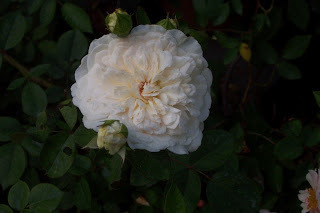 The number of rose varieties may have been limited in ancient times to a few spring/summer blooming varieties, but they had a lot of "tricks" to get them to bloom in off seasons. Pliny wrote that in Carthage, Spain, the roses could be forced to bloom in the winter, and then the roses of Campania bloomed next, followed by those of Malta and lastly Paestum, which flowered in the spring and again in the fall. The species, whatever it may have been, that bloomed in Paestum may be the one used by the gardeners in Seneca's time in Rometo force in warm-green-houses or retard blooming by withholding water at certain periods.
The number of rose varieties may have been limited in ancient times to a few spring/summer blooming varieties, but they had a lot of "tricks" to get them to bloom in off seasons. Pliny wrote that in Carthage, Spain, the roses could be forced to bloom in the winter, and then the roses of Campania bloomed next, followed by those of Malta and lastly Paestum, which flowered in the spring and again in the fall. The species, whatever it may have been, that bloomed in Paestum may be the one used by the gardeners in Seneca's time in Rometo force in warm-green-houses or retard blooming by withholding water at certain periods.Nero was so extravagant that it is recorded that at one fete alone he spend more than four million sesterces, or one hundred thousand dollars (probably more now, due to inflation) in roses alone. The roses were used to wreath their crowns, for garlands, and to cover their tables, couches and the ground. They used them to surround the urns containing the ashes of the dead.
Heliogabalus used so many rose petals at his banquet that some were suffocated on their couches.
Lucius Aurelius Verus had a couch made with four cushions made of very fine net, and filled with rose petals.
Rosalia is a Roman feast celebrating the rose, held each year on May 23.
A rose suspended over a Roman banqueting couch was used to indicate to guests that the conversation was sub rosa and therefore, confidential. This convention was maintained well into the Middle Ages.
Romans often got their winter's supply of roses from Egypt, but eventually learned how to produce roses in winter through the use of green-houses heated by pipes filled with hot water. During the reign of Domitian, this process for forcing roses in winter was so successful that they looked down with scorn on anyone who continued to import roses from Egypt.
Roses were cultivated in Greece, Rome and throughout the East for many purposes, including perfume. One method of preserving the flower was to take a reed, split it down a short distance, stuff it with rose-buds and then bind with papyrus to prevent the scent from escaping. They felt this method could preserve the perfume for a time, if they wished to preserve it while they traveled.
In order to ship roses, the Egyptians in Alexandria and Memphis sent roses in vases and boxes which were planted with roses. They were shipped at the point just when the roses are beginning to break from the bud, in order to arrive in Rome at the most beautiful time when they are expanding. The journey was estimated to take 20 days. No one is sure what roses were grown by the Egyptians. The French, when they explored Egypt, found the white rose (an Alba) and the Centifolia. Speculation exists that the Autumn Damask might also have been grown.
The earliest rose concoctions were Greek in origin. They steeped rose petals in olive or vegetable oil. Later they learned that slowly heating rose petals in water could produce rose water, but it doesn't smell very strongly because not all of the oils in the rose can be dissolved in hot water.
In Persiaor India, they discovered how to distill rose petals: boil rose petals in water, collect the steam, cool it and you have 'attar of rose'. Although this is stronger than rose water, it still doesn't last long. But this is still a key component in perfume. It takes an acre of roses to produce one lb of attar.
Greeks often planted garlic near the roots of roses and thought this helped the fragrance.
 The island of Rhodes really means the Isle of Roses and the Medals of Rhodes have on the reverse side a rose in bloom and on the front, a sunflower.
The island of Rhodes really means the Isle of Roses and the Medals of Rhodes have on the reverse side a rose in bloom and on the front, a sunflower.In the East, the author Abu-Abdallah-ebu-el-Fazel described four roses: the Double White with more than 100 petals; the Yellow; the Purple; and the flesh-colored which is the most common of them all. He also says that the number of species is large, with the Mountain or Wild; the Double which is variegated with red and white shades; and the Chinese. The Double, he says, is the most beautiful and have 40-50 petals.
The Moors in Spainloved roses and reportedly multiplied them through suckers, cuttings, budding and grafting, so these methods are indeed old. One Moorish author indicated the following as a method to for a rose to bloom in autumn:
Choose one which is used to periodical waterings, then deprive it of water entirely during the heat of the summer, until August, and then give it an abundance of moisture. This will hasten its growth and cause the expansion of flowers with great profusion, without impairing its ability to bloom the next spring as usual.
Or, a second method: In October, burn the old branches to the ground, moisten the soil for 8 days and then stop watering. Alternate periods of moisture and drought as many as five times and in 60 days, or before the end of autumn, the roots will have thrown out vigorous branches which will be loaded with blooms, without impairing the plant's ability to bloom again in the spring.
Damascus, Cashmere, Barbary and Fayoum in Egyptall cultivated the rose for distilled oil or rose essence. India was also famous for its rose gardens and the commercial cultivation of the rose. Of all the countries, though, Persia was preeminent for roses during the 14th through 20th century.
MIDDLE AGESRoses were widely cultivated in the Middle Ages and often worn by knights at tournaments as the emblem of their devotion to grace and beauty.
By the 8th century, the Emperor Charlemagne (742-814) issued a decree that all cities would plant roses in their public gardens, as they were thought to have medicinal value.
The Crusades introduced new roses into Europe, including new strains of Damask and Gallica roses. Devout pilgrims to the Holy Lands often brought back roses as well.
When Saladin retook Jerusalemfrom the Christians in 1187 (3rd Crusade) he ordered 500 camel-loads of rosewater from Damascus to purify the Mosque of Omar.
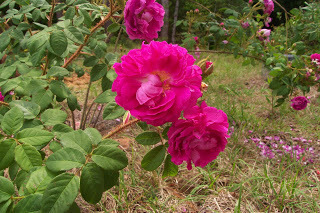 Then there was the famous War of the Roses and its use of roses as emblems for the houses--something created by Shakespeare, by the way. A red rose for the Lancaster and a white for the York. The Yorkhouse most certainly used either the 'Alba Maxima' or 'Alba Semiplena' for their rose. The red is more difficult, but could have been the Apothecary's Rose.
Then there was the famous War of the Roses and its use of roses as emblems for the houses--something created by Shakespeare, by the way. A red rose for the Lancaster and a white for the York. The Yorkhouse most certainly used either the 'Alba Maxima' or 'Alba Semiplena' for their rose. The red is more difficult, but could have been the Apothecary's Rose.In Englandin 1402, Sir William Clopton granted to Thomas Smyth a piece of ground called Dokmedwe, in Haustede, for the annual payment of a rose to Sir William and his heirs, in lieu of all services.
The demand for roses was so great in England that bushels of them were frequently passed by vassals to their lords in England and France.
Among the New Year gifts to Queen Mary in 1556 was a bottle of rose-water.
In an account of a grant of a great part of Ely House, Holborne, by the Bishop of Ely, to Christopher Hatton, for twenty-one years, the tenant covenants to pay, on midsummer-day, a red rose for the gate-house and garden, and for the ground (fourteen acres) ten loads of hay and ten pounds per annum; the Bishop reserving to himself and successors free access through the gate-house for walking in the gardens and gathering twenty bushels of roses yearly.
RENAISSANCEBy the Renaissance, the Dutch and Flemish painters discovered roses and painted the lovely Centifolia. If a rich buyer wanted a yellow "Rose of Provence" (Centifolia) they could certainly have one! (Even if it didn't exist in nature!)
Micholas Culpeper (1616-54) prescribed a dry conserve of rose hips from Rosa canina for weakness, and a conserve of "sugar of rose" to help digestion. Cuttings of the Gallica Rose 'the Apothocary's Rose' or 'Officinalis' were often tucked away by goodwives and others for medicinal purposes.
John Gerard's Herball in 1597 listed 16 different roses, grown in his Holborn garden.
John Parkinson (apothecary to King James I) published Paradisi in Sole Paradisus Terrestris in 1629 and lists 29 roses.
Mary Lawrance's work, A collection of Roses from Nature (the first monograph on roses) in 1795 listed nearly 90 roses.
Pierre-Joseph Redoute published Les Roses between 1817 and 1824, and expanded the list of cultivated roses to nearly 170. The is probably the most famous and influential work on roses.
By 1848, some 1,500 different roses were listed, described, and offered for sale by William Paul's "The Rose Garden" catalogue. There were nearly 800 Alba, Centifolia, Moss, Damask, and Gallica Roses. But, by the time of the 10th edition in 1910, this list of old roses fell to below 90 roses or around 20%, and the bulk of the roses were now as we know them: Hybrid Teas and other remontent classes.
This is obviously just a glimpse of the history, but at least it shows you what a valuable and wonderful plant the rose truly is. Can you imagine being able to lease land by just allowing the owner to come and pick roses from the gardens?
Fiction Writing and Other Oddities
Published on June 26, 2012 06:12
June 18, 2012
How to deal with bullies...in practical terms
Bullied?
So was I and here is practical advice on dealing with it. Make them your best bud.
It's not as crazy as it sounds.
The news is full of stories lately about bullies and there is a lot of fuzzy advice out there that really doesn't help all that much, speaking from my experience that is.
What credentials do I have to even discuss this topic? Well, experience for one thing. And PhD parents (child development and psychology) who thought their children were a pair of lab rats. And dealing with a lot of animals. That last isn't as far-fetched as it sounds, because we're all just glorified animals, and as Cesar Millan always says, "There are no bad dogs, just people in need of retraining." It all amounts to...you.
Here is a relevant truism.
People live up (or down) to your expectations. You expect them to be mean and they will be more than happy to accommodate you.
Side Note: Have you ever noticed how happy-go-lucky people always seem so lucky? Expectation, baby. If you expect to be lucky and you expect to be happy, chances are good it will become a self-fulfilling prophecy. Sure, no one gets 100%, but you get more than your average bear who expects to fail or be unlucky. (This is relevant. Really.)
So, back to the advice bit. I'm going to have to intersperse this with my own story so that it kind of makes sense. I hope.
Back in 8th grade, my gym locker was directly beneath this hood's locker. (In my day, we called the folks who smoked, cut school, and were generally bullies, "Hoods.") She made my life a living hell for the first few days.
Eventually, even my mother noted I was not my usual self.
Side Note: There is no situation that can not be made worse by going to your parents or other person in authority.
I was reluctant to tell her (and rightfully so), but I eventually divulged just enough to get one sentence back from her that changed everything. "Smile. Make friends with her." Of course, Mom also offered to do the parental thing and makes matters a whole lot worse by going to my school, but I deftly handled this by telling her I would handle it myself. No problem. (I hate it when others offer to help me. I'm an independent little cuss. Always have been, always will be.)
The next day, when this hood showed up, I turned to her, smiled, and said, "Hi!" I may have also added, "How's it going?" It's hard to remember every word spoken 40 years ago.
After that, instead of avoiding her, pretending she wasn't really there, or any one of a number of essentially passive and fearful avoidance behaviors, I smiled and talked to her. I even went out of my way to talk to her in the hallways and around school where normally I could have safely avoided her.
She immediately stopped bugging me. Not only that, less than a week later, I found out she'd defended me against some other kids ( had no idea and really should have thanked her).
We didn't exactly become best friends, but the bullying stopped. Turns out her life wasn't all cake and roses, either. She was interesting, too, even if our friendship was pretty much limited to a few classes in school. I often wonder what happened to her, because she was traveling a very hard road. I hope her life got easier, because she was never really as tough as she made out to be.
Were my actions manipulative or fake? Possibly. I know my immediate reaction to what my mother advised was, "You've got to be kidding me!" But over time, I've realized that smiling does make a difference (there are even physiological changes that occur when you smile...but that's another story and my interest in biology coming out).
People who smile and exhibit easy-going confidence (as opposed to confrontational behavior) will almost always diffuse a bad situation. Project the idea that you like the person in front of you. After all, most bullies are greeted with fear, avoidance, and downright hatred. That's bound to make anyone hostile. If you start greeting people with affable good humor (something few see now-a-days), you'll be amazed at the results.
Lessons Learned
Cesar Millan, in working with dogs, would immediately recognize the lessons here.
Projecting fear, avoidance, and the attendant emotional responses is like chum to a shark. Even if you have no confidence whatsoever, you project it. Walk like you have someplace to go. Shoulders back. Plaster a smile on your face. Believe that it is possible to like any humanoid facing you, even the drooling, knuckle-dragging ones.Do not avoid. That's like running away from a lion. The lion's (bully's) first impulse will be to attack and kill. When confronted, do not tense up. Relax. Smile. Show an interest in the other person. What's the worst that can happen?Your Action Plan
So here are the practical steps.
You run into the bully. Smile. Stand your ground, but keep your body relaxed. Under no circumstances will you avoid the bully. Be glad to see the bully. Really.At a minimum, say, "Hi." If you feel you need to say more, just ask general social questions like, "How are you?" If you can, say, "I'm glad to see you. Are you going to be in class today?" And really project that you are, indeed, glad to see this person.Response. Initially, you may get a negative response like, "Why?" or "Are you crazy?" Your response. Shrug. Smile. Say something/anything that is even vaguely positive like, "I don't know, I just think you're kind of interesting/cool." Of course, try to avoid sexual connotations here or things may disintegrate. :)Another negative response. The bully is probably still unsure what is going on and may be angry because of it. Expect something like, "You're a total jerk/idiot."Your response. Chuckle. (I mean it, chuckle like the bully said something really funny--even if it was a terrible insult. Believe that the response was just joking around.) Shake your head and smile. Say, "You crack me up." Then make an offer like, "You on your way to class?" and gesture/wave to indicate you wouldn't mind the bully's company to walk to class.If you persist and meet the bully's reactions with humor, you will diffuse the situation. You may even end up with a new best bud. Or not. But at least you will stop being the victim and stop projecting, "Victimize me!"
Finally, I know a lot of you are thinking, "Easy for you to say." Or even, "Yeah? Well, you don't understand. I'm miserable at school and I hate these people. I'm not happy, and I'm going to plaster a happy smile on my face and be a total fake."
That's fine. But just realize that you are making a choice when you do that. You're choosing to be miserable and victimized. The power is in your hands. Use it or lose it.
Of course, in the end, your mileage may vary. And this works in the office, too, not just in school. Dealing with other people is very much like dealing with aggressive dogs and other animals. To a large extent, their reaction is entirely dependent upon what you project. Project confidence and ease, and the others will relax, too.
Most of all, just be happy!Fiction Writing and Other Oddities
So was I and here is practical advice on dealing with it. Make them your best bud.
It's not as crazy as it sounds.
The news is full of stories lately about bullies and there is a lot of fuzzy advice out there that really doesn't help all that much, speaking from my experience that is.
What credentials do I have to even discuss this topic? Well, experience for one thing. And PhD parents (child development and psychology) who thought their children were a pair of lab rats. And dealing with a lot of animals. That last isn't as far-fetched as it sounds, because we're all just glorified animals, and as Cesar Millan always says, "There are no bad dogs, just people in need of retraining." It all amounts to...you.
Here is a relevant truism.
People live up (or down) to your expectations. You expect them to be mean and they will be more than happy to accommodate you.
Side Note: Have you ever noticed how happy-go-lucky people always seem so lucky? Expectation, baby. If you expect to be lucky and you expect to be happy, chances are good it will become a self-fulfilling prophecy. Sure, no one gets 100%, but you get more than your average bear who expects to fail or be unlucky. (This is relevant. Really.)
So, back to the advice bit. I'm going to have to intersperse this with my own story so that it kind of makes sense. I hope.
Back in 8th grade, my gym locker was directly beneath this hood's locker. (In my day, we called the folks who smoked, cut school, and were generally bullies, "Hoods.") She made my life a living hell for the first few days.
Eventually, even my mother noted I was not my usual self.
Side Note: There is no situation that can not be made worse by going to your parents or other person in authority.
I was reluctant to tell her (and rightfully so), but I eventually divulged just enough to get one sentence back from her that changed everything. "Smile. Make friends with her." Of course, Mom also offered to do the parental thing and makes matters a whole lot worse by going to my school, but I deftly handled this by telling her I would handle it myself. No problem. (I hate it when others offer to help me. I'm an independent little cuss. Always have been, always will be.)
The next day, when this hood showed up, I turned to her, smiled, and said, "Hi!" I may have also added, "How's it going?" It's hard to remember every word spoken 40 years ago.
After that, instead of avoiding her, pretending she wasn't really there, or any one of a number of essentially passive and fearful avoidance behaviors, I smiled and talked to her. I even went out of my way to talk to her in the hallways and around school where normally I could have safely avoided her.
She immediately stopped bugging me. Not only that, less than a week later, I found out she'd defended me against some other kids ( had no idea and really should have thanked her).
We didn't exactly become best friends, but the bullying stopped. Turns out her life wasn't all cake and roses, either. She was interesting, too, even if our friendship was pretty much limited to a few classes in school. I often wonder what happened to her, because she was traveling a very hard road. I hope her life got easier, because she was never really as tough as she made out to be.
Were my actions manipulative or fake? Possibly. I know my immediate reaction to what my mother advised was, "You've got to be kidding me!" But over time, I've realized that smiling does make a difference (there are even physiological changes that occur when you smile...but that's another story and my interest in biology coming out).
People who smile and exhibit easy-going confidence (as opposed to confrontational behavior) will almost always diffuse a bad situation. Project the idea that you like the person in front of you. After all, most bullies are greeted with fear, avoidance, and downright hatred. That's bound to make anyone hostile. If you start greeting people with affable good humor (something few see now-a-days), you'll be amazed at the results.
Lessons Learned
Cesar Millan, in working with dogs, would immediately recognize the lessons here.
Projecting fear, avoidance, and the attendant emotional responses is like chum to a shark. Even if you have no confidence whatsoever, you project it. Walk like you have someplace to go. Shoulders back. Plaster a smile on your face. Believe that it is possible to like any humanoid facing you, even the drooling, knuckle-dragging ones.Do not avoid. That's like running away from a lion. The lion's (bully's) first impulse will be to attack and kill. When confronted, do not tense up. Relax. Smile. Show an interest in the other person. What's the worst that can happen?Your Action Plan
So here are the practical steps.
You run into the bully. Smile. Stand your ground, but keep your body relaxed. Under no circumstances will you avoid the bully. Be glad to see the bully. Really.At a minimum, say, "Hi." If you feel you need to say more, just ask general social questions like, "How are you?" If you can, say, "I'm glad to see you. Are you going to be in class today?" And really project that you are, indeed, glad to see this person.Response. Initially, you may get a negative response like, "Why?" or "Are you crazy?" Your response. Shrug. Smile. Say something/anything that is even vaguely positive like, "I don't know, I just think you're kind of interesting/cool." Of course, try to avoid sexual connotations here or things may disintegrate. :)Another negative response. The bully is probably still unsure what is going on and may be angry because of it. Expect something like, "You're a total jerk/idiot."Your response. Chuckle. (I mean it, chuckle like the bully said something really funny--even if it was a terrible insult. Believe that the response was just joking around.) Shake your head and smile. Say, "You crack me up." Then make an offer like, "You on your way to class?" and gesture/wave to indicate you wouldn't mind the bully's company to walk to class.If you persist and meet the bully's reactions with humor, you will diffuse the situation. You may even end up with a new best bud. Or not. But at least you will stop being the victim and stop projecting, "Victimize me!"
Finally, I know a lot of you are thinking, "Easy for you to say." Or even, "Yeah? Well, you don't understand. I'm miserable at school and I hate these people. I'm not happy, and I'm going to plaster a happy smile on my face and be a total fake."
That's fine. But just realize that you are making a choice when you do that. You're choosing to be miserable and victimized. The power is in your hands. Use it or lose it.
Of course, in the end, your mileage may vary. And this works in the office, too, not just in school. Dealing with other people is very much like dealing with aggressive dogs and other animals. To a large extent, their reaction is entirely dependent upon what you project. Project confidence and ease, and the others will relax, too.
Most of all, just be happy!Fiction Writing and Other Oddities
Published on June 18, 2012 07:35
June 14, 2012
JASNA and Last Chance for a Free Copy of Escaping Notice
Just got back from Maryland where I had a wonderful time at a book fair hosted by the Jane Austen Society of North America (I'm joining, too--these folks are wonderful!). I was thrilled (not to mention intimidated) by the amazing authors who did readings from their books and there were a ton of fascinating books for sale. I had to really resist adding more than a few books to my library, which is already full to overflowing.
The author panel included: Sandy Lerner, Margaret Sullivan, Catherine Reef, Janet Mullany, Lori Smith, and Diana Peterfreund. Oh, and me. Everyone was so nice that I hope they'll make this an annual event as it is a terrific way to start the summer season.
Speaking of which...to celebrate, I'm offering my latest bestseller, Escaping Notice, free for the next three days. That is, Thursday, June 14 through Saturday, June 16, 2012. Here's a bit about it and a teeny-tiny excerpt. Hope you enjoy it!
Escaping Notice
Discarded by his betrothed with a parting sally that “being an earl does not excuse being a bore,” Hugh Castle, the Earl of Monnow, joins his brother on a relaxing cruise, hoping to forget. But a storm capsizes their boat, and despite Hugh’s desperate efforts, he can’t save his brother’s life. Then, when the wreckage reveals evidence of sabotage, he realizes he was never meant to return to dock. Someone intending to murder the earl killed his younger brother, instead. Angered and grieving, Hugh travels to London to enlist the aid of the Second Sons Inquiry Agency in finding his brother’s murderer.
Helen Archer attended the Earl of Monnow’s ball in expectation of joining the celebration for his betrothal, but the event seems destined for disaster. She arrives late, the earl makes no announcement, and Helen manages to lose the fabled (but cursed) Peckham necklace her sister reluctantly loaned to her. Unwilling to admit her carelessness to her sister, Helen rashly decides to return to the earl’s estate and retrieve it in secret.
When his aunt threatens to send him to the Earl of Monnow, his purportedly cruel uncle, Edward Leigh-Brown decides he’s had enough of female interference. He’s going to join the navy and follow in Lord Nelson’s footsteps to become a military hero. But finding his way to London is a lot harder for a young boy than it seems, and he’s soon lost. When he bumps into Miss Helen Archer at an inn, he’s more than happy to accept a ride in her carriage, even if she seems determined to escort him to an inquiry agency to hire someone to locate the family he doesn’t want located.
When the three meet in London at Second Sons, Helen impulsively decides to accompany Hugh to the earl’s home. They will be disguised as servants and free to pursue their secret goals. Hugh hopes to uncover a killer, Helen hopes to find her necklace, and Edward just hopes he can find the opportunity to escape again.
 ExcerptIn this scene, Helen Archer has met up with a young boy, Edward, and has offered to convey him to London in her carriage. She little realizes what an expert Edward is at impromptu fiction, particularly when he wants to get rid of unwanted company. Chapter Seven“A chief part of his duty consists in assisting in the rough work ….” —The Complete Servant
ExcerptIn this scene, Helen Archer has met up with a young boy, Edward, and has offered to convey him to London in her carriage. She little realizes what an expert Edward is at impromptu fiction, particularly when he wants to get rid of unwanted company. Chapter Seven“A chief part of his duty consists in assisting in the rough work ….” —The Complete Servant
Edward Brown-Leigh studied Mr. Stewart as Miss Archer left the room. The man was really offensive, another word which had recently come into his vocabulary and was already proving useful. Edward wanted to punch him in his red nose for the way he stared at the delicate Miss Archer.
“You were lucky, sir,” Edward said when the man turned towards him. Despite teasing Miss Archer, Edward had rather liked her. She was pretty and she hadn’t treated him like a sapskull, two qualities which immediately endeared her to him. He was also tired enough after walking all day with his heavy valise to be grateful to her for her offer to take him to London tomorrow in her carriage.
He did not like Mr. Stewart, however. Or the way his beady little eyes had followed Miss Archer.
After Edward’s comment, Mr. Stewart laughed, although it had a hollow, false note.
“Lucky? I agree. It was a lovely piece of luck to find the inn so full that I was forced to share a room with such a charming couple as you and your fair sister.”
Edward shook his head and fixed a pious expression on his face. “Oh, indeed. But what was lucky was that my sister hadn’t the opportunity to serve you anything to drink.”
“To drink?” Mr. Stewart echoed Edward’s words before giving another, less hearty, laugh.
“You saw the blue vial she carries?” Edward shook his head mournfully.
“Yes. What of it? Just smelling salts or some similar medicine. All delicate ladies carry such things.”
Edward sighed. “If it was only that ….”
“Only that?”
“We’re going to London to see a doctor, you see. I only hope we can get there without any more … incidents.”
“Incidents?”
“Yes. I probably shouldn’t tell you about our difficulties, but it’s been preying on my mind ever since father took ill last winter and left it up to me to see that my sister gets the care she needs. I’m only praying she won’t end up in Bedlam, though if another man …. Well, I shouldn’t tell you our troubles.”
“Bedlam?” Mr. Stewart’s voice squeaked. His ruddy face grew pale although his blob of a nose remained bright cherry red.
“Yes. You see, my sister is easily annoyed by strange men. And when she gets annoyed, she has a way of slipping a little something extra into their drink.”
“Poison? Why in God’s name isn’t she locked up?”
“Oh, she hasn’t actually killedanyone.” He smiled reassuringly and widened his eyes to prove his earnestness. “Not yet, anyway. And fortunately, she listens to me and is quite docile when I'm present. We have every hope for a cure after we get to London. We’re going to see a specialist.”
Lifting his hat in one hand, Mr. Stewart wiped his sleeve over his brow. When the door behind him opened, he jerked violently, hitting the table with his hip. Edward stared at the floor to keep from laughing at the expression on Mr. Stewart’s face when Miss Archer entered the room, followed by a woman Edward presumed to be her maid.
“Oh, you’re back!” Mr. Stewart exclaimed. “I’m dreadfully sorry, but you must excuse me. Terribly sorry.” He dashed past the two women who stared after him, open-mouthed.
Edward smiled triumphantly at Miss Archer and was rewarded with a puzzled look that made him somewhat nervous. A slight frown pinched the skin between her brows. If she heard what he had told Mr. Stewart, she might take it amiss.
He shuffled his feet and gazed at the door, wondering if discretion really was the better part of valor as The Aunts had insisted.
Perhaps they’d been mistaken about that and he should admit the truth to Miss Archer and hope for the best. * * * * *
For those who have more eclectic tastes in literature and a fondness for short stories, you might be interested to know that Edward Brown-Leigh is my small tribute to H. H. Munro, who wrote under the pseudonym of Saki. Munro was rather plagued by Aunts, as well (yep, that's Aunts with a capital "A") and he might feel a great deal of sympathy for poor Edward. Munro is one of my all-time favorite authors and I never tire of reading his biting, witty short stories.
And if you've read any of Munro's stories, you might say that just like Edward, romance at short notice was his specialty, too. (I hope fans of his story, "The Open Window" won't roll their eyes too much. I know, it's a groaner.)
Have a wonderful weekend!
Fiction Writing and Other Oddities
The author panel included: Sandy Lerner, Margaret Sullivan, Catherine Reef, Janet Mullany, Lori Smith, and Diana Peterfreund. Oh, and me. Everyone was so nice that I hope they'll make this an annual event as it is a terrific way to start the summer season.
Speaking of which...to celebrate, I'm offering my latest bestseller, Escaping Notice, free for the next three days. That is, Thursday, June 14 through Saturday, June 16, 2012. Here's a bit about it and a teeny-tiny excerpt. Hope you enjoy it!
Escaping Notice
Discarded by his betrothed with a parting sally that “being an earl does not excuse being a bore,” Hugh Castle, the Earl of Monnow, joins his brother on a relaxing cruise, hoping to forget. But a storm capsizes their boat, and despite Hugh’s desperate efforts, he can’t save his brother’s life. Then, when the wreckage reveals evidence of sabotage, he realizes he was never meant to return to dock. Someone intending to murder the earl killed his younger brother, instead. Angered and grieving, Hugh travels to London to enlist the aid of the Second Sons Inquiry Agency in finding his brother’s murderer.
Helen Archer attended the Earl of Monnow’s ball in expectation of joining the celebration for his betrothal, but the event seems destined for disaster. She arrives late, the earl makes no announcement, and Helen manages to lose the fabled (but cursed) Peckham necklace her sister reluctantly loaned to her. Unwilling to admit her carelessness to her sister, Helen rashly decides to return to the earl’s estate and retrieve it in secret.
When his aunt threatens to send him to the Earl of Monnow, his purportedly cruel uncle, Edward Leigh-Brown decides he’s had enough of female interference. He’s going to join the navy and follow in Lord Nelson’s footsteps to become a military hero. But finding his way to London is a lot harder for a young boy than it seems, and he’s soon lost. When he bumps into Miss Helen Archer at an inn, he’s more than happy to accept a ride in her carriage, even if she seems determined to escort him to an inquiry agency to hire someone to locate the family he doesn’t want located.
When the three meet in London at Second Sons, Helen impulsively decides to accompany Hugh to the earl’s home. They will be disguised as servants and free to pursue their secret goals. Hugh hopes to uncover a killer, Helen hopes to find her necklace, and Edward just hopes he can find the opportunity to escape again.
 ExcerptIn this scene, Helen Archer has met up with a young boy, Edward, and has offered to convey him to London in her carriage. She little realizes what an expert Edward is at impromptu fiction, particularly when he wants to get rid of unwanted company. Chapter Seven“A chief part of his duty consists in assisting in the rough work ….” —The Complete Servant
ExcerptIn this scene, Helen Archer has met up with a young boy, Edward, and has offered to convey him to London in her carriage. She little realizes what an expert Edward is at impromptu fiction, particularly when he wants to get rid of unwanted company. Chapter Seven“A chief part of his duty consists in assisting in the rough work ….” —The Complete Servant
Edward Brown-Leigh studied Mr. Stewart as Miss Archer left the room. The man was really offensive, another word which had recently come into his vocabulary and was already proving useful. Edward wanted to punch him in his red nose for the way he stared at the delicate Miss Archer.
“You were lucky, sir,” Edward said when the man turned towards him. Despite teasing Miss Archer, Edward had rather liked her. She was pretty and she hadn’t treated him like a sapskull, two qualities which immediately endeared her to him. He was also tired enough after walking all day with his heavy valise to be grateful to her for her offer to take him to London tomorrow in her carriage.
He did not like Mr. Stewart, however. Or the way his beady little eyes had followed Miss Archer.
After Edward’s comment, Mr. Stewart laughed, although it had a hollow, false note.
“Lucky? I agree. It was a lovely piece of luck to find the inn so full that I was forced to share a room with such a charming couple as you and your fair sister.”
Edward shook his head and fixed a pious expression on his face. “Oh, indeed. But what was lucky was that my sister hadn’t the opportunity to serve you anything to drink.”
“To drink?” Mr. Stewart echoed Edward’s words before giving another, less hearty, laugh.
“You saw the blue vial she carries?” Edward shook his head mournfully.
“Yes. What of it? Just smelling salts or some similar medicine. All delicate ladies carry such things.”
Edward sighed. “If it was only that ….”
“Only that?”
“We’re going to London to see a doctor, you see. I only hope we can get there without any more … incidents.”
“Incidents?”
“Yes. I probably shouldn’t tell you about our difficulties, but it’s been preying on my mind ever since father took ill last winter and left it up to me to see that my sister gets the care she needs. I’m only praying she won’t end up in Bedlam, though if another man …. Well, I shouldn’t tell you our troubles.”
“Bedlam?” Mr. Stewart’s voice squeaked. His ruddy face grew pale although his blob of a nose remained bright cherry red.
“Yes. You see, my sister is easily annoyed by strange men. And when she gets annoyed, she has a way of slipping a little something extra into their drink.”
“Poison? Why in God’s name isn’t she locked up?”
“Oh, she hasn’t actually killedanyone.” He smiled reassuringly and widened his eyes to prove his earnestness. “Not yet, anyway. And fortunately, she listens to me and is quite docile when I'm present. We have every hope for a cure after we get to London. We’re going to see a specialist.”
Lifting his hat in one hand, Mr. Stewart wiped his sleeve over his brow. When the door behind him opened, he jerked violently, hitting the table with his hip. Edward stared at the floor to keep from laughing at the expression on Mr. Stewart’s face when Miss Archer entered the room, followed by a woman Edward presumed to be her maid.
“Oh, you’re back!” Mr. Stewart exclaimed. “I’m dreadfully sorry, but you must excuse me. Terribly sorry.” He dashed past the two women who stared after him, open-mouthed.
Edward smiled triumphantly at Miss Archer and was rewarded with a puzzled look that made him somewhat nervous. A slight frown pinched the skin between her brows. If she heard what he had told Mr. Stewart, she might take it amiss.
He shuffled his feet and gazed at the door, wondering if discretion really was the better part of valor as The Aunts had insisted.
Perhaps they’d been mistaken about that and he should admit the truth to Miss Archer and hope for the best. * * * * *
For those who have more eclectic tastes in literature and a fondness for short stories, you might be interested to know that Edward Brown-Leigh is my small tribute to H. H. Munro, who wrote under the pseudonym of Saki. Munro was rather plagued by Aunts, as well (yep, that's Aunts with a capital "A") and he might feel a great deal of sympathy for poor Edward. Munro is one of my all-time favorite authors and I never tire of reading his biting, witty short stories.
And if you've read any of Munro's stories, you might say that just like Edward, romance at short notice was his specialty, too. (I hope fans of his story, "The Open Window" won't roll their eyes too much. I know, it's a groaner.)
Have a wonderful weekend!
Fiction Writing and Other Oddities
Published on June 14, 2012 17:34



